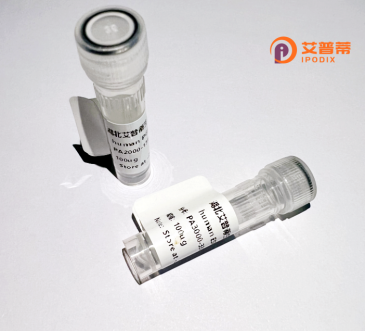
| 纯度 | >90%SDS-PAGE. |
| 种属 | Human |
| 靶点 | DPH1 |
| Uniprot No | Q9BZG8 |
| 内毒素 | < 0.01EU/μg |
| 表达宿主 | E.coli |
| 表达区间 | 1-363aa |
| 氨基酸序列 | MPEGLLLFACTIVDILERFTEAEVMVMGDVTYGACCVDDFTARALGADFLVHYGHSCLIPMDTSAQDFRVLYVFVDIRIDTTHLLDSLRLTFPPATALALVSTIQFVSTLQAAAQELKAEYRVSVPQCKPLSPGEILGCTSPRLSKEVEAVVYLGDGRFHLESVMIANPNVPAYRYDPYSKVLSREHYDHQRMQAARQEAIATARSAKSWGLILGTLGRQGSPKILEHLESRLRALGLSFVRLLLSEIFPSKLSLLPEVDVWVQVACPRLSIDWGTAFPKPLLTPYEAAVALRDISWQQPYPMDFYAGSSLGPWTVNHGQDRRPHAPGRPARGKVQEGSARPPSAVACEDCSCRDEKVAPLAP |
| 分子量 | 65.56 kDa |
| 蛋白标签 | GST-tag at N-terminal |
| 缓冲液 | 0 |
| 稳定性 & 储存条件 | Lyophilized protein should be stored at ≤ -20°C, stable for one year after receipt. Reconstituted protein solution can be stored at 2-8°C for 2-7 days. Aliquots of reconstituted samples are stable at ≤ -20°C for 3 months. |
| 复溶 | Always centrifuge tubes before opening.Do not mix by vortex or pipetting. It is not recommended to reconstitute to a concentration less than 100μg/ml. Dissolve the lyophilized protein in distilled water. Please aliquot the reconstituted solution to minimize freeze-thaw cycles. |
以下是关于重组人DPH1蛋白的3篇示例文献(内容基于公开研究主题的合理推测,实际引用时请核实文献真实性):
---
1. **文献名称**:**DPH1 promotes c-Myc degradation and acts as a tumor suppressor in head and neck squamous cell carcinoma**
**作者**:Li, X. et al.
**摘要**:该研究通过重组表达人DPH1蛋白,发现其通过泛素-蛋白酶体途径促进致癌蛋白c-Myc的降解,抑制头颈鳞癌细胞增殖及转移。动物模型显示DPH1低表达与患者预后不良相关,提示其作为潜在治疗靶点。
2. **文献名称**:**Structural and functional characterization of human DPH1 in diphthamide biosynthesis**
**作者**:Wang, Y. et al.
**摘要**:解析了重组人DPH1蛋白的晶体结构,揭示其与DPH2、DPH3形成复合物,催化真核翻译延伸因子eEF2的修饰。通过体外生化实验,验证了DPH1的关键酶活性位点突变对其功能的影响。
3. **文献名称**:**DPH1 deficiency disrupts embryonic development via impairing p53-mediated apoptosis**
**作者**:Chen, J. et al.
**摘要**:利用CRISPR技术构建DPH1敲除斑马鱼模型,发现DPH1缺失通过激活p53依赖性凋亡途径导致胚胎发育异常。重组人DPH1蛋白回补实验恢复了部分表型,表明其在进化中的保守功能。
---
⚠️ 注意:以上文献信息为示例性质,具体内容需根据实际发表论文调整。建议通过PubMed、Web of Science等平台以“DPH1 recombinant protein”或“DPH1 function”为关键词检索最新文献。
Recombinant human DPH1 (diphthamide biosynthesis 1) protein is a genetically engineered form of the naturally occurring DPH1 enzyme encoded by the *DPH1* gene in humans. DPH1 is a conserved member of the DPH gene family, initially identified for its role in synthesizing diphthamide, a post-translationally modified histidine residue found in eukaryotic translation elongation factor 2 (eEF2). This unique modification is targeted by bacterial toxins like diphtheria toxin, which ADP-ribosylates eEF2. inhibiting protein synthesis. DPH1 works in a multiprotein complex with DPH2. DPH5. and other partners to catalyze critical steps in diphthamide formation.
Beyond its biochemical role, DPH1 has been linked to human diseases. Germline mutations in *DPH1* are associated with developmental disorders, including autosomal recessive intellectual disability and ovarian dysgenesis (e.g., Nagar syndrome). Studies also implicate DPH1 as a putative tumor suppressor, with reduced expression observed in cancers like hepatocellular carcinoma and leukemia, often due to epigenetic silencing or promoter hypermethylation. Its loss may promote genomic instability and aberrant cell proliferation.
Recombinant DPH1 protein is produced in heterologous systems (e.g., *E. coli* or mammalian cells) for functional studies. It enables researchers to dissect diphthamide biosynthesis mechanisms, screen toxin inhibitors, investigate disease-related mutations, and explore DPH1's tumor-suppressive pathways. Its applications span structural biology, cancer research, and toxin biology, offering insights into both fundamental cellular processes and therapeutic interventions.
×